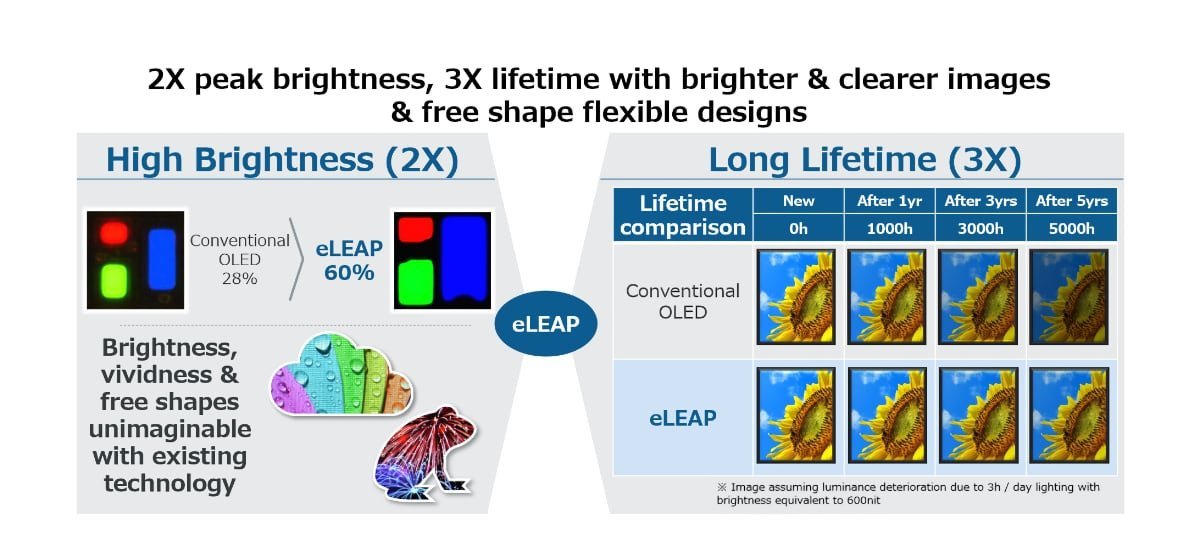The South Korean display-making giants LG and Samsung could soon be facing a new competitor in the shape of Japan Display and Chinese firm HKC. The two companies have announced their intention to form a strategic alliance in order to mass produce eLEAP OLED displays, starting in 2025.

Japan Display first announced eLEAP last year, claiming that it’s an entirely new method of making OLED displays. eLEAP stands for “environment positive, Lithography with maskless deposition, Extreme long life, low power, and high luminance, Any shape Patterning” but what’s more important to remember are Japan Display’s claims about the new tech. According to it, eLEAP OLED will double the efficiency and peak brightness of existing OLED technologies, and last three-times longer.
They are certainly very bold claims, but Japan Display justified them last year by saying its technology boasts a larger aperture ratio, which refers to how much of the space in each OLED pixel can be used to generate light. The larger the space devoted to producing light, the brighter the pixel will be. With conventional OLED displays, the aperture ratio is a mere 28%, but with eLEAP, Japan Display says it has expanded this to 60%.
Existing OLED displays, such as the LG Electronics G2 and Samsung S95B TVs, are already incredibly popular with consumers and reviewers alike thanks to the high level of precision and contrast they enable. Moreover, LG and Samsung both claim to have made significant advances when it comes to brightness with this year’s displays, such as the LG G3 and Samsung S95C.
However, those new displays still reach the same high level of brightness as the most expensive LCD LED TVs, resulting in more reflections on the screen and poorer quality pictures in well lit rooms. In order to reach higher brightness, LG Display’s OLED panels include an extra white LED that can impact the colour range a little. Its displays also have shorter lifespans than LCD panels and there is also the possibility of burn-in, though recent improvements have mimimised the chances of this happening.
Japan Display’s eLEAP technology promises to fix all of these issues, with up to double the brightness of existing displays, meaning OLED would be much closer to the highest-end LCD TVs. With higher brightness, there would be no need for a white pixel, which means an improved colour range. eLEAP also uses less power, reducing the heat and therefore lessening the chances of burn-in.
It remains to be seen whether or not eLEAP can really deliver on these promises, but we will hopefully find out in a couple of year’s time. Japan Display, which was founded after the merger of Sony’s, Toshiba’s and Hitachi’s display panel businesses, said it will partner with HKC to “build world class eLEAP fabs, targeting mass production in 2025". The new factories will be established in China, the partners said.
"JDI believes that eLEAP and HMO (High Mobility Oxide) represent once-in-a-generation revolutionary advances in display technology,” Japan Display said in a statement. “Providing eLEAP and HMO to other display manufacturers is thus an opportunity to create an entirely new global display ecosystem that delivers unprecedented cost performance for customers all over the world.”
The two companies say they will produce eLEAP OLED panels for monitors, notebooks, tablets, virtual reality headsets, automotive displays and wearables. Japan Display further claims to have shipped its first samples to customers back in August 2022, so we can assume there is interest in the technology.
Japan Display and HKC are nothing if not ambitious - they state that they intend to become the number one supplier of OLED displays for wearables by 2027, before taking the lead in the automotive, VR and monitor markets by 2028. That same year, they also aim to be the world’s number three supplier of OLED panels for notebooks and tablets.
It’s a lot of tough talking, but for now the companies are yet to follow through. They haven’t yet actually signed any official agreements, but stated their partnership will commence in June once the relevant contracts have been signed.